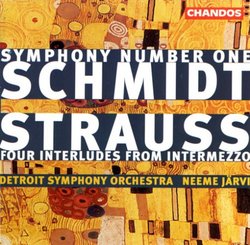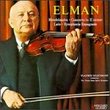| All Artists: Franz Schmidt, Richard [1] Strauss, Neeme Järvi, Detroit Symphony Orchestra Title: Schmidt: Symphony No. 1; Strauss: Four Interludes from Intermezzo Members Wishing: 0 Total Copies: 0 Label: Chandos Release Date: 1/23/1996 Genre: Classical Styles: Opera & Classical Vocal, Historical Periods, Modern, 20th, & 21st Century, Symphonies Number of Discs: 1 SwapaCD Credits: 1 UPC: 095115935729 |
Search - Franz Schmidt, Richard [1] Strauss, Neeme Järvi :: Schmidt: Symphony No. 1; Strauss: Four Interludes from Intermezzo
 | Franz Schmidt, Richard [1] Strauss, Neeme Järvi Schmidt: Symphony No. 1; Strauss: Four Interludes from Intermezzo Genre: Classical
|
Larger Image |
CD DetailsSimilar CDs |
CD ReviewsA master symphonist that deserves to be better known ! N. Daniele Pietro | Milano, MI Italy | 06/15/2000 (5 out of 5 stars) "I admit that I didn't know anything about Schmidt before reading Michael Steinberg's priceless book "The symphony" . This is one the most rewarding discoveries I owe Mr. Steinberg! Schmidt lived in the culturally thriving Vienna of the 20s, the Vienna of Mahler and Strauss, and while there's something of Strauss in his rich orchestrations, Schmidt learned from Bruckner, that he much admired, the love for the grand symphonic form. Schmist made no concessions to the flamboyant, sometimes bombastic form of the symphonic poem, nor to the anguished neurosis of Mahler So, think about a grand Brucknerian symphony but with Viennese Romantic charm instead of the mysticism, less brass, more strings and woodwinds, lush Straussian (or Korngoldian, if you want) orchestrations , a good amount of severe Reger counterpoint, and you'll get a rough idea of a Schmidt symphony. May sound like a mixed bag, but make no mistake, Schmidt's works are entirely personal and well-integrated: they are full of personal ideas and wonderful (may I dare to say catchy?) melodies, and his skill in using all the orchestral possibilities is magnificent throughout. Also, Schmidt's is a real symphonic "cycle", because each one of the four symphonies has its own individual "character" , showing very clearly the composer's evolution. The 1st is an affirmative work : it's still somewhat derivative from the models mentioned above (he was just 24) , but the talent for architectural development, the real symphonist's mark, is apparent throughout. It's an effusively late-Romantic work, but with an intriguing post-Baroque taste for polyphony, and already personal. The 2nd , is the most decadently rich of the four, it's lushly sweeping , with grandly shaped climaxes which inevitably remind the listener of Bruckner. If you like to wallow in lavish sounds, you'll love this one. The 3rd is, in my opinion, a splendid work: it's more graceful than sumptuos, the orchestration is leaner. The mood is overall lighter and less decadent , the melodies (the Adagio!) charmingly poignant, the final movement (a chorale introduction followed by a noble, dignified dance-like section) is, among Schmidt's finest things. The 4th, regarded by many as Schmidt's masterpiece, stands a bit apart from the others : the mood is much darker (it was inspired by Schmidt's grief for his daughter's death), and the form is unusually daring. The whole, massive one-movement symphony blossoms from one instrument's solo, a stupendously eerie trumpet phrase which, through wonderfully inventive developments (among them, a stunning funeral march) leads us to the shatteringly percussive climax. Once more, kudos to the Jarvi/Chandos partnership for their adventuresome repertoire choices, and for recording them with top-notch orchestras. The playing is very accomplished and idiomatic throughout, especially considering that this is not exactly "standard" repertoire. If the live-recorded Chicagoans bring their special plus of virtuosity to the 2nd and 3rd, the Detroit Symphony matches them in the other two (I'd even say that they produce a more "viennese" sound). Richly warm, well-detailed Chandos engineering, fuller in the Detroit studio recordings, Among the (too few!) Schmidt cycles currently on the market, this is surely the first choice but, if you can find it, also get the Gramophone Award-winner recording of the 4th by Franz Welser-Most and the LPO on EMI, it's really special." "Brahms's 5th Symphony"? Jeffery A. Triggs | New Jersey | 05/24/2006 (5 out of 5 stars) "This is ravishingly beautiful music from start to finish! It
deserves to be much better known than it is. BUY IT and START ENJOYING IT! Some critics have commented on the "baroque" feeling of the opening bars of the first movement. There is something Handelian about it. But it is a lushly romantic piece through and through. The opening "baroque" passage for the brass section fades out leaving the strings soaring off in soul-like, "weightless" freedom. It produces a glorious effect. A moving trumpet solo follows leading to a theme for the horns that some might consider reminiscent of Richard Strauss. There are also some lovely Schumann-like passages. But make no mistake - in spite of such reminiscences, the music is true Franz Schmidt throughout. Strauss never constructed such a firm sonata form movement, and it is really the architecture that drives the music so satisfactorily. The second movement contains some of the most beautiful clarinet solos I have ever heard, at one point played against a horn choir for a thrilling effect. Schmidt was a master of playing different orchestral choirs against each other. The scherzo movement is a sheer delight from beginning to end, almost Brucknerian in feeling but with a lightness and elegance of touch that Bruckner himself could have used more often. The trios introduce lilting melodies with a distinctive Austrian flavor that leave you wishing for more. The final movement launches into a fugue that Reger might have envied, mixes in a stirring chorale, and ends in a triumphal apotheosis delighting in its own musicality. What began perhaps with an appreciative glance at Handel ends with a veritable homage to Bach. Yet the work is thoroughly romantic in the best sense and displays a composer with a powerful and unique voice. In its sophisticated and assured command of form, orchestration, and melody, it stands apart from all but the greatest "first" symphonies. Neeme Jarvi and the Detroit Symphony do a splendid job throughout. It is easy to forget about the elegant excerpts from Strauss's Intermezzo that round out the CD. I love Strauss, but this is really Schmidt's CD. If you are not allergic to late romantic music, you will not regret buying this CD!" |

 Track Listings (8) - Disc #1
Track Listings (8) - Disc #1

